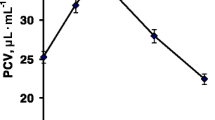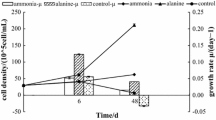Abstract
The addition of the proper amount of ammonium to the culture medium containing nitrate as nitrogen source enhanced the growth rate of Anabaena viguieri. The amount of geosmin produced by these cells varied with the concentrations of ammonium added. A negative correlation between the amount of geosmin produced and of the growth rate of cells was revealed. This was also found in cells grown on various forms of nitrogen sources. Without supply of any nitrogen compound, this organism is capable of fixing gaseous nitrogen, and under these conditions the cells grew relatively slowly. However, they produced more geosmin (per unit protein mass) than cells grown in the presence of combined nitrogen. The isolation of heterocysts, in which nitrogen was fixed, showed that these cells produced higher amounts of geosmin than vegetative cells. The possible relation of nitrogen assimilation to the production of geosmin in the cells was discussed.
Similar content being viewed by others
References
Bentley R, Meganathan R (1981) Geosmin and methylisoborneol biosynthesis in streptomycetes. FEBS Lett 125: 220–222
Bradford MM (1976) A rapid and sensitive method for the quantitation of microgram quantities of protein utilizing the principle of protein-dye binding. Anal Biochem 72: 248–254
Gerber NN (1968) Geosmin from microorganisms, is trans-1,10-dimethyl-trans-9-decalol. Tetrahedron Lett 25: 2971–2974
Gerber NN (1969) A volatile metabolite of Actinomycetes, 2-methylisoborneol. J Antibiotics 22: 508–509
Izaguirre G, Hwang CJ, Krasner SW, McGuire MJ (1982) Geosmin and 2-methylisoborneol from cyanobacteria in three water supply systems. Appl Environ Microbiol 43: 708–714
Jüttner F (1984) Dynamics of the volatile organic substances associated with cyanobacteria and algae in an eutrophic shallow lake. Appl Environ Microbiol 47: 814–820
Jüttner F, Leonhardt J, Möhren S (1983) Environmental factors affecting the formation of mesityloxide, dimethylallylic alcohol and other volatile compounds excreted by Anabaena cyclindrica. J Gen Microbiol 129: 407–412
Jüttner F, Höflacher B, Wurster K (1986) Seasonal analysis of volatile organic biogenic substances (VOBS) in freshwater phytoplankton populations dominated by Dinobryon, Microcystis and Aphanizomenon. J Phycol 12: 169–175
Kuo SR, Ting YY (1989) Studies on the water quality of tiger prawn, eel and fish-cum-duck ponds in Southwestern Taiwan. COA Fisheries Ser (Taiwan) 16: 113–141
Lind OT, Katzif SD (1988) Nitrogen and the threshold odor number produced by an Actinomycete isolated from lake sediments. Wat Sci Technol 20: 185–191
Matsumoto A, Tsuchiya Y (1988) Earth-musty odor-producing cyanophytes isolated from five water areas in Tokyo. Wat Sci Technol 20: 179–183
Medsker LL, Jenkins D, Thomas JF, Koch C (1969) Odorous compounds in natural waters. 2-Exo-hydroxy-2-methylbornane, the major odorous compound produced by several Actinomycetes. Environ Sci Technol 3: 476–477
Miwa M, Morizane K (1988) Effect of chelating agents on the growth of blue-green algae and the release of geosmin. Wat Sci Technol 20: 197–203
Naes H, Post AF (1988) Transient states of geosmin, pigments, carbohydrates and proteins in continuous cultures of Oscillatoria brevis induced by changes in nitrogen supply. Arch Microbiol 150: 333–337
Naes H, Utkilen HC, Post AF (1988) Factors influencing geosmin production by the cyanobacterium Oscillatoria brevis. Wat Sci Technol 20: 125–131
Naes H, Utkilen HC, Post AF (1989) Geosmin production in the cyanobacterium Oscillatoria brevis. Arch Microbiol 151: 407–410
Ogawa T, Vernon LP (1971) Increased content of cytochrome 554 and 562 in Anabaena variabilis. Biochim Biophys Acta 226: 88–97
Persson PE (1983) Off-flavours in aquatic ecosystems. An introduction. Wat Sci Technol 15: 1–11
Schacterle GR, Pollack RP (1973) A simplified method for the quantitative assay of small amounts of protein in biological material. Anal Biochem 51: 654–655
Tabachek JL, Yurkowski M (1976) Isolation and identification of blue-green algae producing muddy odor metabolites, geosmin and 2-methylisoborneol, in saline lakes in Manitoba. J Fish Res Board Can 33: 25–35
Tang HC, Lin TS (1989) Study on the investigation of freshwater cultured environment and muddy odor in cultured fish in Northern Taiwan. COA Fisheries Ser (Taiwan) 16: 1–21
Weete JD, Blevins WT, Wilt GR, Durham D (1977) Chemical, biological, and environmental factors responsible for the earthy odor in the Auburn city water supply. Auburn Univ Agri Expt Sta Bull 490, Auburn AL
Wu JT, Jüttner F (1988a) Effect of environmental factors on geosmin production by Fischerella muscicola. Wat Sci Technol 20: 143–148
Wu JT, Jüttner F (1988b) Differential partitioning of geosmin and 2-methylisoborneol between cellular constituents in Oscillatoria tenuis. Arch Microbiol 150: 580–583
Wu JT, Hsu YM (1988) Relation of algae to earthy odors of fish in Taiwan. Bot Bull Academia Sinica 29: 183–188
Wu JT, Zhan SM (1989) Phytoplankton in fishponds and its relation to earthy odor of fish in Taiwan. COA Fisheries Ser (Taiwan) 16: 23–83
Yagi M (1988) Musty odour problems in Lake Biwa. Wat Sci Technol 20: 133–142
Author information
Authors and Affiliations
Rights and permissions
About this article
Cite this article
Wu, JT., Ma, PI. & Chou, TL. Variation of geosmin content in Anabaena cells and its relation to nitrogen utilization. Arch. Microbiol. 157, 66–69 (1991). https://doi.org/10.1007/BF00245337
Received:
Accepted:
Issue Date:
DOI: https://doi.org/10.1007/BF00245337




